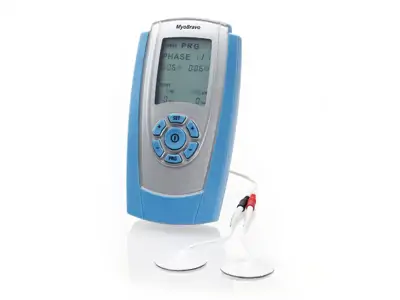Multiple Sclerosis
Multiple sclerosis is a chronic inflammatory condition of the central nervous system (brain and spinal cord). Muscle spasms, muscle stiffness (spasticity), muscle weakness, pain and incontinence can cause most problems
Read more...Multiple sclerosis is a chronic inflammatory condition of the central nervous system (brain and spinal cord). Muscle spasms, muscle stiffness (spasticity), muscle weakness, pain and incontinence can cause most problems. Symptoms sometimes increase and sometimes decrease, but usually slowly get worse.
With electrical muscle stimulation you can reduce muscle stiffness, improve muscle strength, coordination, balance, walking ability and performance of daily activities. Let's look at the possible areas of application.
Reducing spasticity
In multiple sclerosis, the connection between the muscles and the motor nerves that run to them is damaged. As a result, your muscles become increasingly stiff and tense. This prevents you from performing movements and can even increase to the point of pain.
In medical jargon, the condition is called spasticity (increased muscle tension, stiffness).
With the right muscle stimulation, the muscle can be relaxed. The innervation nerve also "relearns" the correct tone. Tension is eliminated, pain and involuntary sprains are also reduced.
Maintaining or improving joint range of motion
Spastic muscles (i.e. stiffness) can prevent you from using the full range of motion of your joints, for example, you may not be able to stretch your elbows or knees, or only partially.
With muscle stimulation, the muscles can be relaxed so that your range of motion can be expanded.
Improving muscle strength and performance
If spasticity is reduced or eliminated, or range of motion is improved, this can make the muscles feel stronger, even though the strength of the muscle fibres has not yet been altered.
Muscle stimulation can also be used to improve muscle contraction timing and "recruitment", i.e. to contract muscle fibres simultaneously, more efficiently and in a more coordinated manner.
You can improve core strength and reduce muscle fatigue by combining physiotherapy exercises with muscle stimulation.
Improving bladder and rectal sphincter control
Multiple sclerosis can be a sub-symptom of incontinence, i.e. inability or inadequacy to hold urine or stool. It is caused by a weakening of the pelvic floor sphincter muscles and a "disruption" of their motor nerve.
The majority [75-85%] of people with multiple sclerosis treated with functional muscle stimulation report improved rectal and bladder function.
Reducing the risk of respiratory infection
While people with multiple sclerosis can walk, they are unlikely to have impaired respiratory muscle function. However, for those already confined to a wheelchair, arm and chest muscle activity is reduced, there is an impeded breathing pattern and an increased risk of respiratory tract infection.
One of the most serious problems is a reduced ability to cough.
Functional stimulation can be helpful in maintaining the strength of the abdominal and trunk muscles. It helps to cough and keep the airways clear. Reducing the stiffness of these same muscles can improve breathing and coughing by allowing deeper inhalation and improving the coordination of the expiratory muscles.
Minimising the risk of flatulence
Pressure ulcers can develop as a result of a combination of factors, including spasticity, joint stiffness and limited mobility, muscle paralysis and a poorly designed wheelchair.
Muscle stimulation can help reduce the risk. Improved joint range of motion, easier changes in posture, and reduced involuntary movement alone can help. By maintaining muscle mass and tone, pressure is distributed more evenly over the skin, which dampens the pressure on the bone.
In cases of pressure ulcers, stimulation can speed up the healing process. Improved microcirculation leads to improved oxygenation of the skin and muscle, and increases scar tissue formation, reducing the risk of infection.
Back to top...








